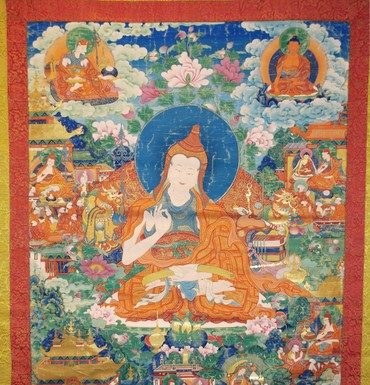Lamrim outline: Introduction

I. Preeminent qualities of the compilers
II. Preeminent qualities of the teachings
III. How the teachings should be studied and taught
Introduction
I. The preeminent qualities of the compilers
II. The preeminent qualities of the gradual path teachings
As presented in Atisha’s Lamp of the Path:
1. It shows how all the doctrines of the Buddha are non-contradictory
2. It shows how all the teachings can be taken as personal advice
3. The ultimate intention of the Buddha—to lead all beings to enlightenment by giving a variety of teachings—will easily be found
4. One will avoid the error of sectarian views regarding a Dharma lineage or doctrine
As presented in Lama Tsongkhapa’s Great Exposition on the Gradual Path to Enlightenment:
1. It encompasses the entire lamrim subject matter
2. It is easily applicable
3. It is endowed with the instructions of the two lineages (of Manjushri and Maitreya)
Practice teachings which:
1. have their source in the Buddha
2. difficult points of which were clarified by great Indian pandits
3. have been practiced by sages
III. The way the lamrim should be studied and taught
Qualities of a teacher:
1. Of a Vinaya master:
a. Compassion for sick people
b. Has attendants with good qualities
c. Helps disciples with material and teachings
- (In Lama Chopa, instead of b. and c. as here, it has b. Wise in all three baskets and c. Keeps precepts taken from other masters)
d. Pure ethics
e. Knowledge of Vinaya
f. Able to teach any teaching at any time
2. Of a Mahayana mentor:
a. Subdued physical and verbal behavior through practicing the higher training in ethics
b. Subdued mind through practicing the higher training in concentration
c. Very subdued through practicing the higher training in wisdom
d. More knowledge in verbal and realizational Dharma than student
e. Richness in verbal doctrine, i.e., has studied a lot
f. Richness in the realizational doctrine, i.e. deep, stable realization of emptiness
g. Joy and enthusiasm for teaching
h. Ability to express him/herself clearly
i. Loving concern and compassion for students, teaches with pure motivation
j. Willing to put up with the difficulties of guiding others
Qualities of the student:
1. Free from preconceptions, open-minded, not overwhelmed with attachment and aversion
2. Discriminating intelligence
3. Interest, commitment, wants to understand and experience the path
A. The way to study (listen to) the Dharma
1. Consider the benefits of listening
2. Showing courtesy to the Dharma and the teacher
3. The actual way to study
a. Avoiding the three faults, using the analogy of a pot
1) Upside-down pot
2) Pot with hole in bottom
3) Dirty vessel
b. Relying on the six recognitions
1) Oneself as a sick person
2) The teacher as a skilled doctor
3) Dharma as the medicine
4) Practicing the Dharma as the way to get cured
5) Buddha as holy being whose medicine of Dharma is non-deceptive
6) Methods we learn are things we should pray exist and flourish
B. How to explain the Dharma
1. Considering the benefits of explaining the Dharma
2. Enhancing the courtesy shown to the Buddha and Dharma
3. Thought and actions with which to teach
4. The difference between whom to teach and whom not
C. The concluding stage common to both teacher and student
Venerable Thubten Chodron
Venerable Chodron emphasizes the practical application of Buddha’s teachings in our daily lives and is especially skilled at explaining them in ways easily understood and practiced by Westerners. She is well known for her warm, humorous, and lucid teachings. She was ordained as a Buddhist nun in 1977 by Kyabje Ling Rinpoche in Dharamsala, India, and in 1986 she received bhikshuni (full) ordination in Taiwan. Read her full bio.

